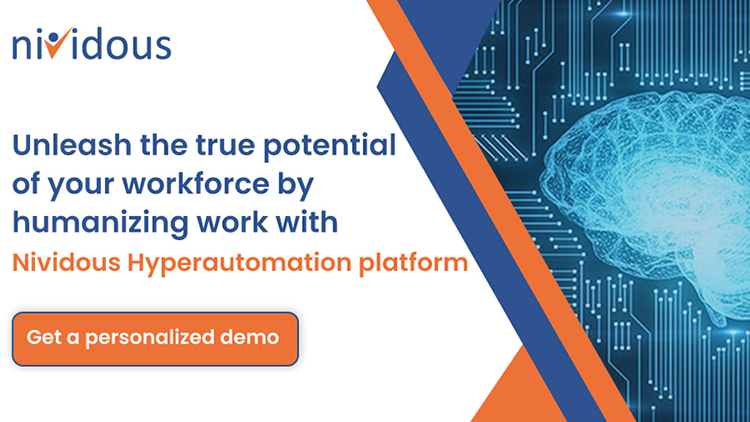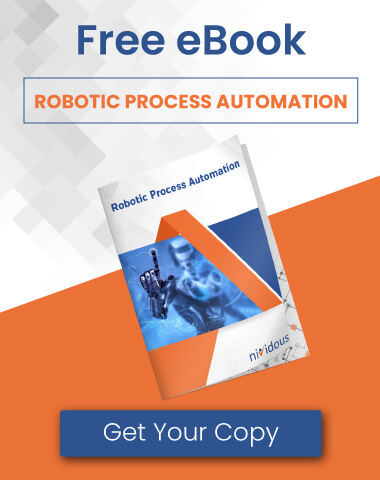According to McKinsey, 25% of the insurance industry will be automated by 2025. Indeed, most insurance companies are now using robotic process automation (RPA) in one way or another. While that’s a good thing overall, the current RPA strategy of automating singular tasks within larger processes is leading to the creation of automation “silos.” Such silos may provide immediate tactical benefits, but they also stand in the way of greater organizational efficiency.
That leaves insurers feeling like they’ve hit a new roadblock that needs solving: How can automation weave complex processes together more holistically—and in a way that adds value to the business?
The future of automation in the insurance industry—and the solution to this challenge—is hyperautomation. Here’s what robotic process automation looks like in today’s insurance industry and how hyperautomation takes RPA to the next level.
Eager to transform your insurance operations with Artificial Intelligence?
Watch our on-demand webinar to discover actionable strategies on how AI and intelligent automation can empower your business to conquer soaring costs and meet the evolving expectations of customers.
The Need For Robotic Process Automation In Insurance
In many ways, insurance products are becoming commodities. Digitization has made it easy for new players to enter the industry, putting pressure on established insurance firms to drive down prices. As a result, most insurers are looking at how to boost their decreasing profit margins.
Increasingly, insurance products are finding their way into customers’ hands not through insurance professionals but through channel partners—corporate agents, car dealerships, financial advisors, and more—most of whom want the option to deliver insurance products digitally. This is a welcome opportunity for insurance companies, but it also poses something of a challenge: Few companies are well-equipped to build a mass of new digital product configurations, much less to support them. They continue to struggle with:
- Time-consuming manual processes. Many insurers still heavily rely on people to get things done, like rekeying information from one application to another and gathering data from multiple sources. The inordinate amount of time spent on these activities would decrease the benefits produced by a strategic partnership—and would, in most cases, limit the potential number of such partnerships.
- Legacy applications. Most insurers have a legacy core system that is difficult to manage on an organizational level. These sprawling, complex systems were not designed with configurability in mind and cannot support the modernization and efficiency efforts required to adequately sustain such partnerships.
To overcome these challenges and support hundreds of channel partner relationships, insurers must explore the advantages of automation—specifically, the advantages of applying RPA to insurance processes.
Why isn’t RPA enough?
There’s no doubt that insurers must employ technology to remain competitive—and until now, RPA was the best solution.
But RPA only automates a small piece of a larger task. To solve a complex business problem, you need a holistic automation approach.
The process of issuing insurance coverage is multifaceted and complex—a combination of steps that require both the intelligence and insights of people along with simple decision-making abilities that an RPA bot could handle. Hyperautomation is about automating a process from end to end, orchestrating it all to maximize efficiency.
10 Real Examples of Hyperautomation & RPA In Insurance
1. With Nividous, a leading life insurance agency automated the scrutinization of new policy applications for underwriting:
- RPA bots fetched application forms and supporting documents for cases under scrutiny.
- Smart bots with native Computer Vision-based Optical Character Recognition (OCR) capabilities extracted relevant data.
- RPA bots performed all required validations on the extracted data against an internal application and documents.
- Based on the validations, RPA bots raised change requests in case of missing documents or corrections, approved and passed the policy for issuance if all validations are met, or passed the proposal to an underwriter when critical decisions were required.
- RPA bots handled change request cases when the requirement is fulfilled.
2. Nividous helped one client with their initial customer interactions and customer onboarding:
- RPA bots quickly automated fraud detection and non-productive tasks so employees can focus on customer relationships.
- Hyperautomation technologies performed on-device data retrieval for use in other steps of the process.
- RPA bots assisted in applying strict identity verification laws for insurance companies around the world—from verifying SSN or Individual Taxpayer Identification Numbers (ITIN) in the U.S. to standards such as KYC (Know Your Customer) in Europe and APAC. The best way to verify that customers meet these standards via document validation and photo matching is through API bots, but many companies are shifting to RPA for double-checking potential customers’ identities with high accuracy.
3. One insurance company using Nividous gained automated tracking of new policies:
- Intelligent automation systems automatically tracked proposals and reported on their status as they moved through company checks.
- Automation dashboards offered insights and reports on how proposals and applications were progressing, centralizing the important information.
- AI-aided OCR data extraction grabbed data from applications for tracking purposes.
- RPA bots performed more than 100 possible checks on incoming information.
4. A leading insurance firm gained automated customer service case classification through Nividous:
- RPA bots continuously monitored a CRM application to manage the high influx of service requests.
- Smart bots read and understood the requests and classified them into relevant categories for a service desk agent to handle.
- If all the required information was available, the bot performed necessary actions to address the request and sent a success email to the requester. If the request lacked any required information, the bot sent an email asking the requestor to share the necessary information.
- In cases of low confidence, RPA bots moved the emails to an exception folder for manual categorization.
6. For one company, Nividous helped automate premium calculations for channel partner integrations:
- RPA bots performed complex calculations on multiple Excel sheets (and several tabs within single Excel documents) to generate quotes used by sales reps in real-time.
- The bots made it possible for users to generate over 5,000 quotes per day. This type of automation enabled a service-based architecture, allowing quick and seamless integration with partner banks, mobile applications, and core business systems.
7. A top life insurance company tamed its backlog of applications with the help of RPA:
- Struggling to manage an underwriting backlog, the underwriting team needed an automation solution that was scalable and flexible.
- With the help of Nividous smart bots, the company was able to reduce the number of people working on underwriting by 70-80 people and increase productivity by several times, quickly eliminating the backlog.
8. RPA improved the above company’s time to revenue:
- Before RPA automation, this company’s special product offering wasn’t as profitable as they expected, in part due to strict regulations that complicated the application and quoting process. Team members at this company were forced to engage in time-consuming back-and-forth communication with partners to gain new customers, as well.
- RPA bots reduced the 45-minute quote calculation time for this product to four seconds, increasing customer satisfaction.
- The automated process integrated with the company’s existing app and partner banks, allowing the company to sell more and create a separate business entity dedicated to that single product.
- The company has now seen at least $60 million in new revenue from this one product alone.
9. Nividous helped another insurance company achieve accuracy and speed in its financial reporting:
- Before automation, a small team of workers combed through multiple websites, downloading reports manually, resulting in inaccurate data and low productivity.
- Nividous employed RPA bots to automate the data grab, pinpoint field details in the extracted data, and double-check accuracy.
- This change resulted in an 85% reduction in manual efforts, a hugely improved turnaround time, and over 95% accuracy in financial reports.
10. With Nividous’s help, a leading insurance firm was able to process policy data faster:
- The company fielded policies from 60+ different insurers and had to extract data from dozens of fields in multiple formats.
- Internal Developer Program (IDP), BPM, and RPA together achieved a vastly increased turnaround time for this company’s processing department.
- The Nividous platform worked to retrieve policies from various sources, grab the data inside, recognize pertinent data using deep learning and natural-language processing (NLP), and manage the entire policy process.
- The new and improved process was more accurate, required 70% less effort, and could be completed in a fraction of the original turnaround time.
4 Processes That RPA In Insurance Can Facilitate
As an intelligent automation provider, Nividous has clearly helped numerous insurance companies gain control over their specific processes with comprehensive, hyperautomated solutions. In general, RPA can often assist with the following insurance processes:
- Customer onboarding: This type of automation is extremely helpful for insurers, who rely on quick customer onboarding to provide the best coverage to customers purchasing life, health, or other types of insurance. The better the customer experience—which often starts with onboarding—the better positioned they are to carve out a larger share of the market. Insurers competing in the digital market must provide a smooth, seamless, and fast onboarding process.
- Channel partner incentive program calculations: RPA bots can analyze incentive program structures and collect data from the sales generated by channel partners. They can perform incentive calculations with perfect accuracy, ensuring each channel partner gets the appropriate share of profits.Performing incentive program calculations is a complex, manual, Excel-based process that requires large teams and hundreds of hours to complete. RPA can help insurance companies offer timely and accurate incentives, backed up by calculations unique to the insurer. Insurance companies that can handle these types of calculations with accuracy and speed will enjoy a better reputation among valued channel partners.
- Processing claims: Hyperautomation oversees the entire process of claims, from submission to payout. RPA bots access the peripheral system around the central business processes and assist with any data extraction required to check claims.
- Underwriting: Health insurance and life insurance have stringent rules and underwriting processes that require the time and attention of huge teams of people. This includes inspecting insurance application forms and supporting documents, and performing other business checks.Applying business process management can sometimes improve the flow of this entire underwriting process—from receiving the initial customer inquiry to final approval of their application. And with the help of RPA, AI, and even API-driven processes, you may be able to automate all those business processes that have to be run while performing underwriting (even in complex cases).
Need help improving your insurance processes?
If you’re experiencing an efficiency problem or looking for ways to maximize the value of your workers, talk to us at Nividous. We have extensive experience implementing hyperautomation and robotic process automation in insurance and would love to help.
Nividous is one of the very few platforms that offers hyperautomation capabilities—RPA, insurance business process automation, and artificial intelligence—right out of the box. This combination of technologies makes it possible to automate very sophisticated processes (not just single tasks), freeing up your people to do more valuable work. You can avoid the costly strategy of using multiple vendors for automation, and just use one: one platform and one support cost for all your automation needs.
If you’d like to see our platform in action—and talk to us about how it can improve your insurance-related processes—schedule a demo. Or, check out our case studies to see how we’ve helped other insurance companies.






